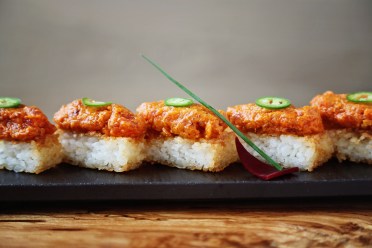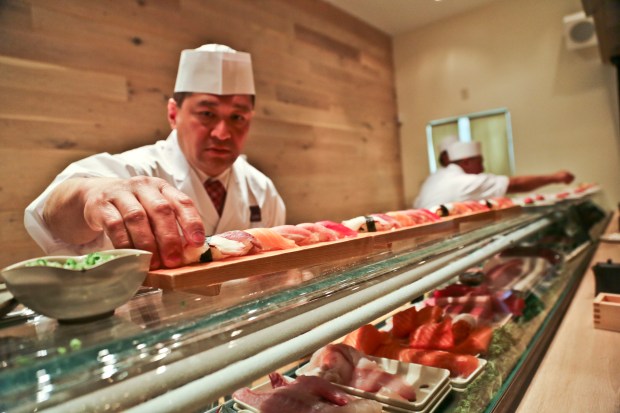We here at The Manual have had our eye on the Atlanta culinary scene for the last year or so. In that time, one of the hottest new restaurants the ATL is the modern Japanese restaurant, Umi.
Located in the city’s Buckhead neighborhood, Umi was founded in 2013 by longtime Atlanta natives Farshid Arshid and Charlie Hendon, along with Chef Fuyuhiko Ito and has quickly taken the city by storm. So much so that Umi was recently named to Open Table’s list of the 100 Hot Spot Restaurants in America.
Recently, we were able to take a little bit of the multi-talented Farshid Arshid’s time and talk to him about his extremely popular new restaurant.
How did you become involved with Umi?
I don’t have a food background. I started in fashion about nineteen years ago in Atlanta then crossed over to the music industry. About five or six years ago I started dining with Chef Ito at an establishment in Atlanta called MF Buckhead.
Unfortunately, MF Buckhead closed and soon after people were calling me and saying that I should open a restaurant. I was reluctant due to the horror stories of the food industry, so I waited a few months. When I saw that the guys behind MF Buckhead were really not opening again, I reached out to Chef Ito on Facebook, which was my only way of contacting him. I asked him if he ever considered opening his own restaurant. And we kind of just started going from there.
How did you decide on the restaurant’s aesthetic?
The room is a thirty-foot by thirty-foot square. It seats about eighty people, which by New York standards is fine, but by southern standards is fairly small. The idea was that when the Chef Ito stands behind the counter, he wants to have the same eye contact with every patron in the room that he would have with the people at the sushi bar. It was one of the things he kept telling me when we were developing the space. So, Chef Ito can see every table and it makes the room very cozy.

What was the vision behind the food at the restaurant?
The menu was very well thought out. About seventy percent of the menu is Chef Ito’s own creation. Then about twenty percent of the menu is made up of well done standards. You know, like the proper execution of yellow tail jalapeno, of black cod miso, rock shrimp tempura—things that I knew that people were yearning for in Atlanta. The final ten to fifteen percent of the menu items are things that sold well at MF Buckhead when Chef Ito was working there.
As our first year has progressed, we’ve learned the room’s tastes and palettes. So we’ve added some new items. Scallops are incredibly popular, so chef is going to do a scallop tiradito dish. We have a very open relationship with our clients. When you sit at the sushi bar, Chef Ito really wants to learn your palette, he wants to know what you like and you enjoy. He genuinely wants everyone to have an enriching experience.
In your mind, what makes Umi a unique Japanese dining experience? What sets it apart from other sushi restaurants?
The fact that we have a proper bar area. In so many Japanese restaurants there is no bar or waiting area where you can relax and just have a drink. Even if it was going to be the smallest place on Earth, we wanted to make sure we had that separation of a bar from the rest of the restaurant. So we have a fourteen-foot bar. So, again, it’s small for the kind of volume of customers that we see, but people really love it and appreciate it.

How does Chef Ito’s wife, Lisa Ito, contribute to the operation?
She is a CIA graduate, and then she got picked up by Francois Payard and worked at Le Bernardin. She then went to work for Guenter Seeger down here in Atlanta where she met Chef Ito at MF Buckhead and they then got married.
Her function was going to just be a pastry chef, but we couldn’t find a chef de cuisine that could execute all of the hot dishes properly, so Lisa jumped in. Pastry was an extremely important component of our service. I always felt that dessert was missing from Japanese dining. Usually the only options are green tea ice cream or red bean. But dessert is a huge part of a dining experience.
What kind of desserts do you offer?
Her piece de resistance is a green tea soufflé. It’s served with a crème anglaise that is infused with green tea. We make ten a night and it has to be ordered when you initially put your order in. We have people that reserve orders because no one else does it—it is her signature dish.
One of her other dishes is a chocolate bento box. It’s a warm chocolate cake with green tea ice cream. During the winter we did pecan pie and for spring we are doing a lighter coconut cake. Then, we are doing a Yuzu cake, which is a take on the love that people have for key lime pie in the South. We needed something citrusy.
What are your thoughts on the Atlanta food scene at the moment?
I’ve been an Atlanta restaurant patron for nineteen years, so I know how good the food has always been. We have always had access to great talent. Within the past two years, a lot of newer, sexier concepts have been coming into the city. And that kind of thing is really starting to stick with restaurant goers. There’s a large amount of support for the concepts. And that is something that maybe didn’t happen in the past. I think it has to do with the fact that a lot of people in our market have become more food savvy.
Images courtesy of Angie Mosier


